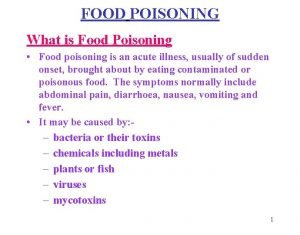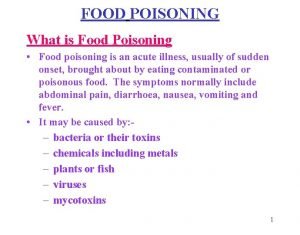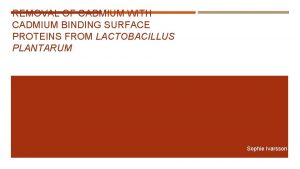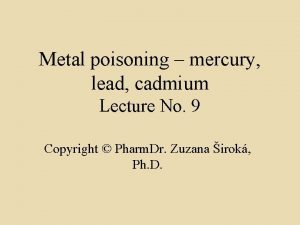Cadmium Poisoning Toxicity Differences in Men and Women







- Slides: 7

Cadmium Poisoning & Toxicity Differences in Men and Women Megan, Elena, Elvina, and Hannah

Differences in Men ● ● ● Overall cadmium poses a much greater threat to women than it does to men because of the way that women’s biology works when it comes to metal retention. However, men typically tend to smoke at higher rates than men and cigarettes are one of the major exposures to cadmium. Age plays a large factor in the absorption of cadmium 13% of the variation in cadmium absorption in men is due to genetic variance One study found that it accumulates in the testes which can lead to problems within the reproductive system Not much research has been done on the specific mechanisms that explain why men don’t absorb cadmium in the same way that women do

Symptoms of Cadmium Toxicity in Men RESPIRATORY SYSTEM - Inhalation of Fumes (mining) & Smoking = COPD, Emphysema, Itai-itai Disease CARDIOVASCULAR SYSTEM - Hypertension, Peripheral Artery Disease (reduced blood flow) KIDNEYS - Cadmium Nephropathy, Renal Cortical Necrosis (Acute High Exposure), Renal Tubular Dysfunction, Kidney Stones REPRODUCTIVE SYSTEM - Low Sperm count, Deterioration of Sperm quality, motility (immature Sperm), Decreased Testosterone and Libido, Testicular tumors

Symptoms of Cadmium Toxicity in Women Respiratory Effects: Chronic obstructive pulmonary disease (COPR) → Smoker and Lung cancer Cancer: increased risk of endometrial cancer (postmenopausal women) and breast cancer Cardiovascular Effects: Peripheral artery disease → the effect of smoking of the disease decreased after adjustment for cadmium levels (lower risk of cardiovascular mortality than man) Renal Effects: Cadmium nephrotoxicity may follow chronic inhalation or ingestion→ associated with renal tubular dysfunction and glomerular damage; Kidney stone (especially in worker), stone formation→ lead to hypercalcemia (excess of calcium in urine) and hyperphosphatemia (excess of phosphate in urine Skeletal Lesions: Bone change → lead to osteomalacia and osteoporosis Reproductive & developmental effect: Cause severe placental and fetal death → during later pregnancy (dose greater than 2. 5 mg/kg); higher urinary cadmium level increase rate of preterm delivery than mothers with lower level; high exposed women cause lower infants birth weight “Itai-itai” disease: First described in postmenopausal Japanese women (exposed through diet) → lead to poor nutrition and postmenopausal status Other effects: Mild anemia, anosmia and yellowing of teeth

Differences in Women - Internal cadmium dose including blood levels, is greater in women due to higher gastro-intestinal absorption in women with iron deficiency. - Pregnancy Menstruation Menopause - Cadmium interferes with calcium metabolism and vitamin D synthesis and affects bones. Itai-itai disease Menopause - Cadmium is a metalloestrogen and endocrine disruptor of multiple reproductive hormones. Pregnancy and progesterone Inhibin B and pubertal development in young girls

Associations between Lead and Cadmium and reproductive Hormones in Peripubertal U. S. Girls Gollenberg, Audra L et al. “Association between lead and cadmium and reproductive hormones in peripubertal U. S. girls” Environmental health perspectives vol. 118, 12 (2010): 1782 -7. “In the subsample of 260 girls with levels of inhibin B above the level of detection and using survey regression modeling, inhibin B levels were lower among girls with both high Pb and high Cd than among girls with high Pb alone, relative to girls with low Pb and low Cd. ”

Citations https: //www. ncbi. nlm. nih. gov/pmc/articles/PMC 5596182/ https: //www. ncbi. nlm. nih. gov/pubmed/2403689 https: //www. sciencedaily. com/releases/2013/05/130509123657. htm https: //journals. plos. org/plosone/article? id=10. 1371/journal. pone. 0186727 https: //www. atsdr. cdc. gov/csem. asp? csem=6&po=12 https: //www. ncbi. nlm. nih. gov/books/NBK 158834/













